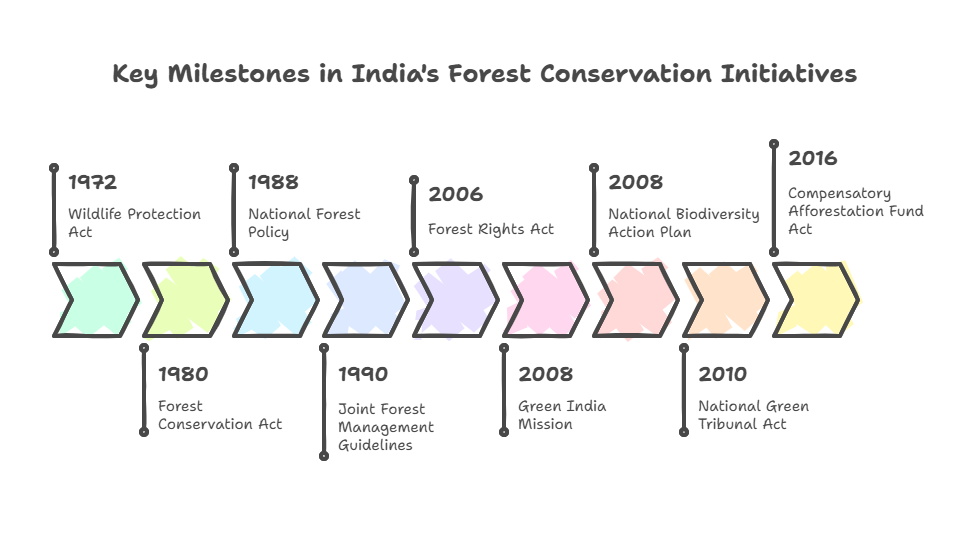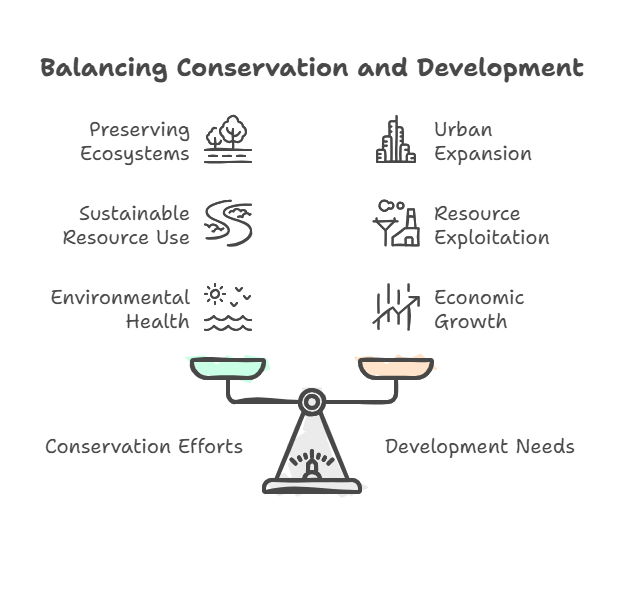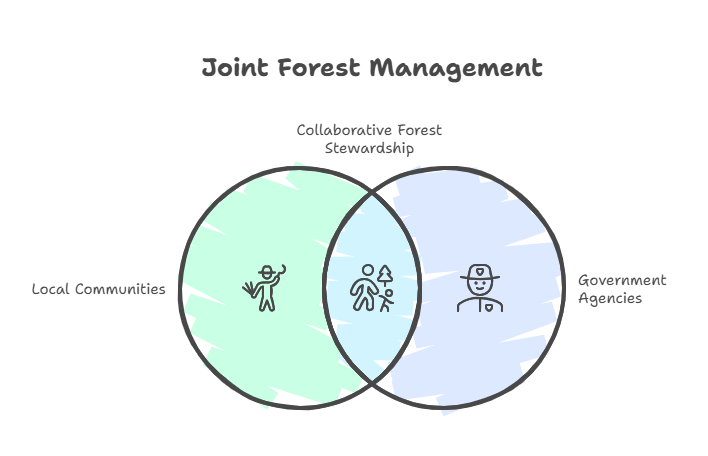Biodiversity & Environment
Revitalizing Forests for a Sustainable India
This editorial is based on “Inclusions and exclusions in India’s forest governance” which was published in The Hindustan Times on 14/07/2025. The article brings into picture the Supreme Court's expansive role in forest governance through the Godavarman case, which broadened the definition of 'forest' but also led to centralized control, often overlooking community-based conservation.
For Prelims: T.N. Godavarman Thirumulpad's Case, India State of Forest Report 2023, Forest Rights Act (2006), National Forest Policy, Western Ghats, Rajasthan's Aravallis, Sundarbans, Kanha National Park, Narmada Basin project, Joint Forest Management, Sustainable Development Goals.
For Mains: Significance of Forests in India, Key Issues Associated with Forest Management in India.
The Supreme Court's involvement in forest governance, initiated by T.N. Godavarman Thirumulpad's 1995 petition, has significantly influenced India's environmental policies. Through the Godavarman case, the Court has expanded the definition of 'forest' to include areas recorded as forest in government records, irrespective of vegetation type. This broad interpretation has led to the inclusion of diverse ecosystems, such as grasslands and scrublands, under forest protection laws. While this approach aims to enhance conservation, it has also centralized forest governance, often sidelining community-based conservation models. As a result, India's forest governance must now consider broader, inclusive conservation models that account for ecological diversity and community rights.
How are Forests a Cornerstone of India’s Ecological and Developmental Vision?
- Ecological Balance and Biodiversity: Forests are crucial in maintaining India's ecological balance by supporting diverse ecosystems.
- The protection of forests ensures the survival of a wide array of species and preserves critical habitats.
- India’s forests are home to ~80% of terrestrial biodiversity, including endangered species like the Bengal tiger and the Asiatic lion.
- As per the India State of Forest Report 2023, India's forest and tree cover constitutes 25.17% of the country’s geographical area, showcasing their ecological importance. The loss of biodiversity, if not managed, risks the collapse of ecosystem services vital for survival.
- Carbon Sequestration and Climate Change Mitigation: Forests play a pivotal role in mitigating climate change by acting as carbon sinks. They absorb large amounts of CO2, thus slowing down global warming.
- India's forests and trees currently store 30.43 billion tonnes of CO2 equivalent, contributing significantly to carbon sequestration.
- The National Forest Policy aligns with global commitments, targeting forest cover expansion to reach 33% of the country’s land area.
- India's NDC target for 2030 includes creating an additional carbon sink of 2.5 to 3 billion tonnes of CO2 equivalent through increased forest and tree cover.
- Livelihood Support for Rural and Tribal Communities: Forests are the lifeblood of over 250 million people in India who directly depend on forest resources for their livelihoods.
- Forests provide timber, fuelwood, medicinal plants, and non-timber forest products (NTFPs) that are crucial for rural economies.
- The Forest Rights Act (2006) seeks to recognize community rights, allowing greater autonomy for forest-dwelling populations.
- Water Cycle Regulation and Soil Conservation: Forests play a key role in regulating water cycles and conserving soil, preventing erosion and floods.
- The depletion of forests directly impacts water availability, especially in drought-prone regions.
- In areas like the Western Ghats and Rajasthan's Aravallis, forests maintain watershed integrity, ensuring water for agriculture and domestic use.
- The India State of Forest Report 2023 notes the critical role of forests in preventing desertification, especially in regions like Rajasthan, where forest cover helps reduce the effects of water scarcity.
- Economic Development and Green Growth: Forests are a vital source of raw materials for industries, contributing to the economy through timber, paper, and pharmaceuticals.
- The growing trend of green businesses, including eco-tourism and sustainable timber, indicates the potential for forests to drive inclusive economic development.
- In states like Telangana, where initiatives like the Haritha Haram program have led to significant increases in forest cover, green development models are creating new job opportunities.
- Disaster Risk Reduction and Resilience: Forests are natural buffers against disasters such as floods, droughts, and landslides, particularly in vulnerable regions.
- They help in reducing the severity of natural disasters by stabilizing soil and absorbing excess rainfall.
- In regions like Uttarakhand, where landslides are frequent, forests have been pivotal in maintaining hillside stability and preventing loss of life.
- Tourism and Cultural Identity: Forests are a significant source of eco-tourism, which drives both local economies and cultural preservation.
- Forests in regions like the Sundarbans and Kanha National Park attract millions of visitors, generating income for local communities and promoting conservation awareness.
- Tourism revenues from wildlife and forest reserves also help fund conservation activities, benefiting both the environment and local communities.
- Wildlife tourism in India has seen a significant annual growth rate of approximately 15%, contributing to the economy and job opportunities.
- Forests in regions like the Sundarbans and Kanha National Park attract millions of visitors, generating income for local communities and promoting conservation awareness.
What are the Key Issues Associated with Forest Management in India?
- Deforestation and Forest Land Diversion: Forests are being cleared for infrastructure projects, mining, and agriculture, which severely impacts biodiversity and climate.
- Despite the Forest Conservation Act (FCA) of 1980 and Supreme Court rulings, forest land continues to be diverted, undermining conservation efforts.
- Also, The 2023 amendments to FCA 1980 exempt certain forest lands from its purview and exclude certain activities from the definition of non-forest purposes.
- The central government approved the diversion of 28,880 hectares of forest land in 2023-24.
- Implementation of Forest Rights Act (FRA): The Forest Rights Act (2006) was a landmark move to recognize and secure the rights of tribal communities over forest resources.
- However, the implementation of the Act has faced significant hurdles, with incomplete recognition of Community Forest Rights (CFR) in many states.
- 16 years after the Forest Rights Act (FRA), over 250 million forest-dependent people still face denial of rights, with states like Madhya Pradesh, Rajasthan, and West Bengal showing zero CFR recognition.
- Conflict Between Conservation and Development: India’s development agenda often clashes with forest conservation goals, creating tension between economic growth and ecological sustainability.
- While forest reserves like national parks and tiger sanctuaries are crucial for biodiversity, the demand for land for industrial development and urbanization is escalating.
- For example, the Narmada Basin project, aimed at increasing irrigation and energy supply, led to deforestation and diversion of significant forest areas.
- Similarly, the Mumbai-Ahmedabad bullet train project threatens forest areas, particularly in Maharashtra's dense forest patches.
- Monoculture Plantations and Loss of Biodiversity: The push for afforestation programs has led to an increase in monoculture plantations, which fail to replicate the biodiversity found in natural forests.
- While tree planting is seen as a solution to mitigate deforestation, it often undermines ecosystem services such as wildlife habitats, soil fertility, and water retention.
- The India State of Forest Report 2023 highlights that a significant portion of new forest cover in India is made up of non-native species like eucalyptus and teak, which provide limited ecological benefits compared to native biodiversity-rich forests. This raises concerns about the long-term ecological health of these areas.
- Forest Governance and Bureaucratic Challenges: The governance of forest resources in India is highly centralized, with the Forest Department controlling most decisions related to forest management, often sidelining local communities.
- The lack of decentralization and community involvement in decision-making has led to inefficiencies and conflicts between the state and forest-dependent communities.
- The ongoing implementation of Joint Forest Management (JFM) schemes remains largely ineffective, with communities often having limited control over forest resources.
- In places like Chhattisgarh, local communities are increasingly calling for more autonomy, but bureaucratic resistance continues to stifle these efforts.
- Loss of Forest-Based Livelihoods: With increasing commercialization of forests, local communities that have depended on forest resources for their livelihoods are being marginalized.
- Forests provide essential resources such as firewood, timber, medicinal plants, and non-timber forest products (NTFPs).
- However, policies such as the privatization of forest resources and restrictions on NTFP collection have threatened the livelihoods of over 250 million people in India.
- For instance, due to unsustainable practices, Lindur village in Himachal Pradesh's Lahaul and Spiti district is on the verge of collapse, with large-scale land subsidence worsening since the 2023 monsoon significantly impacting livelihood in the region.
- Impact of Climate Change on Forests: Climate change is intensifying the challenges faced by forests in India, exacerbating the risks of forest fires, pests, and diseases.
- The India State of Forest Report 2023 also notes that over 92,000 sq km of forest was degraded between 2013 and 2023, with climate change being a significant factor.
- Additionally, more frequent and intense wildfires, driven by global warming, pose a major threat to India’s forest resilience.
- About 34,562 sq km of forests--that is, just over 1% of India's overall area-was burnt in the last fire season from November 2023 to June 2024.
- Encroachment and Illegal Logging: Illegal logging and encroachment on forest lands continue to undermine forest conservation efforts.
- While the government has enacted laws and policies to curb illegal activities, enforcement remains weak, particularly in remote forest areas.
- The rise in illegal timber extraction, especially in states like Madhya Pradesh and Chhattisgarh, where forest areas are rich in valuable timber, poses a significant challenge to conservation.
- Forest encroachments in India are increasing at an alarming rate with government data indicating a whopping 146% rise in a year.
What Measures can India Adopt to Ensure Sustainable Forest Management?
- Integrated Forest Governance with Local Empowerment: India must shift towards decentralized forest governance, where local communities, especially tribal and forest-dwelling populations, play a leading role in decision-making.
- Empowering gram sabhas and local bodies under the Forest Rights Act to manage forest resources with scientific inputs will ensure more sustainable and inclusive forest management.
- The involvement of local communities in forest conservation initiatives ensures better compliance with regulations, reduces conflicts, and encourages traditional ecological knowledge, which is often more suited to local conditions.
- Ecological Restoration Over Monoculture Plantations: Focus on ecological restoration rather than just large-scale monoculture plantations, which often undermine biodiversity.
- Restoration should prioritize native species, ensure habitat connectivity, and address soil and water management.
- Collaborative efforts involving forest departments, research institutions, and local communities can help restore degraded landscapes and provide long-term ecological benefits.
- This approach is more effective in maintaining ecosystem services such as water retention, soil fertility, and wildlife habitat, compared to the generic and temporary gains from monoculture tree planting.
- Strengthening Wildlife Corridors and Protected Area Networks: India must expand and strengthen the network of wildlife corridors that connect isolated protected areas.
- These corridors facilitate the movement of species, preventing genetic isolation and promoting biodiversity. This can be achieved by revisiting land-use policies, ensuring that infrastructure development projects consider wildlife corridors, and investing in ecological restoration of fragmented habitats.
- Promoting Agroforestry for Sustainable Livelihoods: Incorporating agroforestry into farming systems can greatly reduce the pressure on natural forests while supporting local economies.
- Agroforestry involves integrating trees into agricultural landscapes, which can help restore soil fertility, prevent erosion, and enhance water retention.
- Providing incentives, subsidies, and training for farmers to adopt agroforestry practices will not only improve agricultural yields but also ensure that trees are maintained as a resource for both ecological and economic benefits.
- Revamping Forest Management Education and Capacity Building: Enhancing the capacity of forest management professionals and local forest officers through education and continuous training in modern ecological techniques is essential.
- Developing specific programs focusing on climate change, biodiversity conservation, and community engagement will improve the effectiveness of forest governance.
- Moreover, empowering youth through environmental education and training programs will create a generation of forest stewards dedicated to long-term conservation goals.
- Maharashtra’s Gadchiroli district stands out—where empowered local institutions have boosted incomes, created jobs, and conserved forests, inspiring other states to demand similar roles in ecotourism and forest governance.
- Forest Certification and Sustainable Timber Production: To address the growing demand for timber and forest products without degrading forest ecosystems, India should promote sustainable forest certification.
- By developing a framework for forest certification that aligns with international standards (such as scaling up FSC certification to enhance awareness), India can ensure that timber and other forest resources are sourced sustainably.
- This measure would incentivize private landowners and corporations to manage forests responsibly, reduce illegal logging, and promote sustainable trade in forest products.
- Adoption of Technology for Monitoring and Enforcement: Leveraging satellite technology, drones, and AI-powered tools to monitor forest cover, track illegal logging, and assess ecosystem health can significantly enhance forest conservation.
- Real-time data on forest conditions can help detect deforestation, encroachments, and forest fires early, enabling quick intervention.
- The Forest Survey of India (FSI) utilizes data from the MODIS (Moderate Resolution Imaging Spectroradiometer) sensor, which is a significant step in the right direction.
- Using these technologies alongside traditional ground-based monitoring will streamline enforcement and ensure better management practices across vast forested areas.
- Real-time data on forest conditions can help detect deforestation, encroachments, and forest fires early, enabling quick intervention.
- Increasing Public Awareness and Eco-Branding: A national campaign to raise public awareness about the importance of forests for climate, biodiversity, and livelihoods is crucial.
- Additionally, creating eco-brands that market products made from sustainably sourced forest products can generate consumer demand for conservation.
- Public-private partnerships should be encouraged to support forest-friendly business models that help integrate forests into broader economic markets, thus shifting consumer behavior towards more sustainable practices.
- Financial Mechanisms for Forest Conservation: Establishing forest conservation funds sourced from corporate social responsibility (CSR), environmental taxes, and international climate finance could provide a steady stream of funding for long-term conservation efforts.
- These funds can be used for forest protection, restoration, and community development initiatives.
- Furthermore, financial incentives for states that achieve conservation milestones could ensure sustained engagement with forest conservation on the ground.
- Strengthening Legal and Policy Framework for Forest Protection: India needs to strengthen the legal framework for forest protection by introducing stricter penalties for illegal logging, land encroachment, and wildlife poaching.
- Regular audits of forest conservation practices, along with clearer land-use policies that prevent the encroachment of forest areas for developmental projects, will reduce the pressure on forests.
- Ensuring that forest laws are not diluted for short-term development goals will maintain the integrity of forest ecosystems and long-term sustainability.
Conclusion:
Forests in India are crucial to achieving multiple Sustainable Development Goals (SDGs), including life on land (SDG 15), climate action (SDG 13), and decent work and economic growth (SDG 8). They maintain ecological balance, support biodiversity, and regulate water cycles, all while providing livelihoods to over 250 million people. To meet SDGs, India must adopt an inclusive approach that prioritizes both conservation and the rights of local communities. "Forests are the foundation of a sustainable future—protecting them is key to achieving the world we want."
|
Drishti Mains Question: Examine the role of forests in India’s ecological balance and livelihoods. How can forest conservation strategies be aligned with the Sustainable Development Goals |
UPSC Civil Services Examination, Previous Year Question (PYQ)
Prelims
Q1. At the national level, which ministry is the nodal agency to ensure effective implementation of the Scheduled Tribes and Other Traditional Forest Dwellers (Recognition of Forest Rights) Act, 2006? (2021)
(a) Ministry of Environment, Forest and Climate Change
(b) Ministry of Panchayati Raj
(c) Ministry of Rural Development
(d) Ministry of Tribal Affairs
Ans: (d)
Q2. A particular State in India has the following characteristics: (2012)
- It is located on the same latitude which passes through northern Rajasthan.
- It has over 80% of its area under forest cover.
- Over 12% of forest cover constitutes the Protected Area Network in this State.
Which one among the following States has all the above characteristics?
(a) Arunachal Pradesh
(b) Assam
(c) Himachal Pradesh
(d) Uttarakhand
Ans: (a)
Mains
Q. “The most significant achievement of modern law in India is the constitutionalization of environmental problems by the Supreme Court.” Discuss this statement with the help of relevant case laws. (2022)







